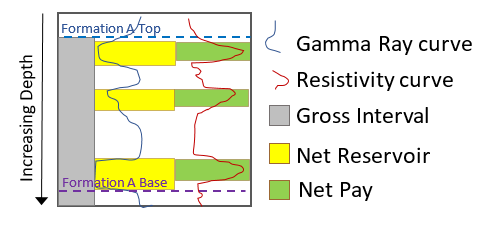
Assessing Net Pay
We have discussed porosity, saturation, and area of the productive trend and how they relate to the question:
How much oil and gas are present?
We understand that oil and gas fill-up pores in the rock and can be described by the parameters porosity and saturation. We understand that the extent of the play (or area) is confined by similar facies (rock characteristics) with similar production capacity. In order to complete our volumetric calculation, we need to also determine what height (h) to apply across the area of producible, hydrocarbon saturated rock.
Recall the simplified volumetric equation to calculate oil and gas resource:

The height (h) is often referred to as net pay. The term net pay is sometimes used in different ways and this can lead to confusion. Sometimes a press release on a newly drilled well touts hundreds of feet of net pay prior to any petrophysical work or thorough degree of drill stem testing or production data. Sometimes the term net pay is used interchangeably with net reservoir or even gross thickness when the terms are distinct. Typical industry conventions define net pay as thickness of producible rock. Producible means that the specific rock interval will flow oil and gas economically. To define net pay mathematically, we use criteria such as oil or gas saturation, porosity, and permeability. Well log data are analyzed and related to production and core data. Then log data “cutoffs” (numerical criteria for various logs) are established which relate to producible rock. By depth through the wellbores, rock is considered to be either pay or non-pay over each pre-defined interval (usually one foot or half foot). The zones of pay are summed for total net pay thickness per wellbore and maps are created to determine spatially an appropriate net pay for the producing area (A).
Total hydrocarbon resource may sometimes be calculated without respect to producibility. This should be defined as “gross” or “total” resource and it should be highlighted that much of the resource is not considered moveable with current technology or economic constraints. Moreover, much of the resource in the gross interval may not be specifically targeted in the wellbore design. For instance, it may be behind pipe, or separated by a frac barrier, or not accessed by a horizontal well per proximity. Gross resource is a useful calculation because it helps identify upside potential: what could possibly be targeted with additional completions or enhanced technology. Nonetheless, gross resource should not be construed as reserves, and gross thickness should not be construed as net pay.
Net reservoir thicknesses may also be calculated. Some may consider net reservoir to be synonymous with gross thickness. However, most industry players consider net reservoir to have the required characteristics to hold and transport economic quantities of oil and gas but may or may not have sufficient hydrocarbon saturation. To summarize, gross rock is defined as the entire interval of interest, net reservoir is comprised of the porous and permeable intervals, and net pay is the interval that meets net reservoir requirements and also saturation requirements for economic production. At Haas Engineering, we define the terms we are using to ensure clarity and we always relate geology to productivity.
Consider the diagram below to illustrate the concepts. The rocks adjacent to the wellbore were evaluated using downhole logging tools which measured gamma rays and resistivity. The entire interval from the top to base of Formation A is considered the gross interval. The portion of the formation that met a certain (low) gamma ray measurement was considered to be net reservoir and identified in this case as porous and permeable sand. The portion of the formation that met the criteria for reservoir and also met a certain (high) resistivity measurement was considered to be net pay, identified as having sufficient hydrocarbons for economic production. In addition, if any of the “Pay” intervals below were left behind pipe, they would be removed from the pay calculation so that pay of producing intervals could be related accurately to production rates. Note that usually many more logs are used in the identification of net pay and a robust pay model is always iteratively tied to production results. Also note that in some cases the productive interval has high gamma ray or low resistivity, in contrast to the example shown here. Understanding the rock type and associated effect on log curves is critical to establishing a pay model and tying it to expected productivity.


Thad Toups is the Owner and President of Haas Engineering. Founded in 1980, we’ve been providing reservoir engineering services and consulting for a vast array of companies in the energy space.

Recent Comments